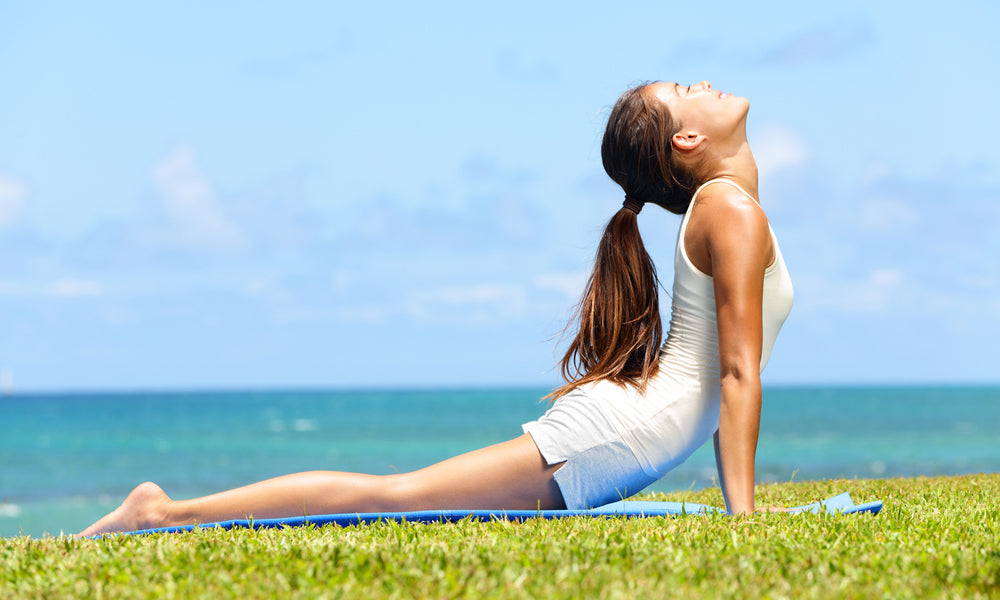For the slightly more experienced paddle boarder who fancies a bit of an extra challenge, SUP yoga can be the perfect next step. Not only are there many health benefits to taking part in paddle board yoga, but it can also help your core strength and stability which is also going to improve your all-round paddle boarding techniques!
Top 3 beginner SUP yoga positions

The great thing about paddle board yoga is that it can be as simple or as challenging as you want it to be. If you’re just starting out, it's important to get the basic positions down before attempting the more difficult ones. The perfect SUP yoga poses to start out with are…
Seated Pose (Sukhasana)

The best pose to begin with is the seated pose, this is the easiest pose to do and will allow you to get a feel for motion of the water before attempting more difficult poses. For seated pose:
- Sit in the middle of your paddle board ensuring you are facing the front
- Cross your legs and either rest your hands on your knees or press your palms together at the center of your chest
- Sit up straight, lengthen the crown of the head towards the sky, relax your shoulders and begin slow, deep breathing
- If safe to do so you can also close your eyes
- Hold the pose for around a minute at a time
Child's Pose (Balasana)

The child's pose is a popular stretch for a number of exercises and is also an ideal pose for those learning SUP yoga. For child’s pose:
- Start on your knees and bring your hands down so you are in a tabletop position with your weight evenly distributed facing the front of the board
- Ensure your belly button is over the middle handle of the board
- Slightly widen your knees and bring your big toes to touch behind you
- Shift your weight back and allow your hips to sink back onto your heels
- As you lower yourself back, gently rest your forehead on the board and keep your arms extended out in front of you
- Breathe deeply and slowly holding the pose for around one minute
Cobra (Bhujangasana)

The final beginners pose in our SUP yoga guide is the cobra, this pose is another beginner friendly position that gives a deep stretch whilst also allowing you to be stable on the board as you ease yourself into SUP yoga techniques. To do a cobra:
- Lie flat on your front facing the front of the board
- Line up your tummy to the handle in the middle of the board
- Bring your palms flat on the board and walk them directly under your shoulders. Bend your elbows straight back and hug them in towards your ribs
- Pause, look straight down to the board, keeping your neck in neutral and pressing your public bone & hips down
- Take a breath in and lift your head and chest away from the board, roll your shoulders back, keep hugging your elbows in towards your ribs and keeping your gaze down. Hold for a moment
- As you exhale release back down to the board.
If you’re into impressing your friends with SUP tricks, have a read of our top 3 beginner paddle boarding tricks.
Where to do paddle board yoga

Technically you can do SUP yoga anywhere that you would normally go paddle boarding, but to get the most out of your experience it is best to look for locations that are:
Calm
Balance is a key component of yoga, both on and off land. When first trying out SUP yoga it is sensible to choose a location where the water is likely to be calmer and flatter. Opt for more secluded waters like lakes and avoid choppier waters like oceans, this will allow you to properly learn the positions and techniques without having the added challenge of bouncy waves to contend with.
Scenic
Mindfulness has always been an important part of yoga, choosing a scenic place for SUP yoga will automatically boost your mood and allow you to feel more connected to the world around you. Take a look at our guide to some of the most beautiful areas to paddle board in the UK.
Quiet
Although not essential, practising SUP yoga in more quiet places can improve your overall experience as you don’t have other distractions. Not only will you be able to fully immerse yourself in the experience, but the absence of other paddle boarders, kayakers and boats will mean less waves and movement in the water that could push you off balance.

Benefits of paddle board yoga
There are a number of benefits to SUP yoga, so why not give it a try! These benefits include:
1. Improves physical fitness
Yoga and paddle boarding are both good low impact forms of exercise. They’re also well known to improve both your flexibility as well as core strength, meaning that your overall fitness levels will increase with yoga on a paddle board.
2. Improves technique
SUP yoga will improve your ability to do yoga and paddle boarding simultaneously. Practising yoga on a paddle board will improve your ability to do yoga on dry land and also improve your ability to balance on a paddle board when not striking a yoga pose. You’ll have increased strength and flexibility meaning you’ll be able to manoeuvre yourself and balance much better.
3. Mental wellbeing
Yoga and paddle boarding have both been known in their own right to have benefits to the mental health of participants, therefore combining the two can only be a good thing. The added bonus of being outdoors means you can enjoy fresh air and some beautiful scenery at the same time.
4. Adaptable
As mentioned previously, SUP yoga can be as challenging or as relaxing as you like, there are no rules on who can and can’t take part. Whether you are a complete beginner to paddle boarding and yoga, or a pro at both, it's great to push yourself and enjoy the activity.











